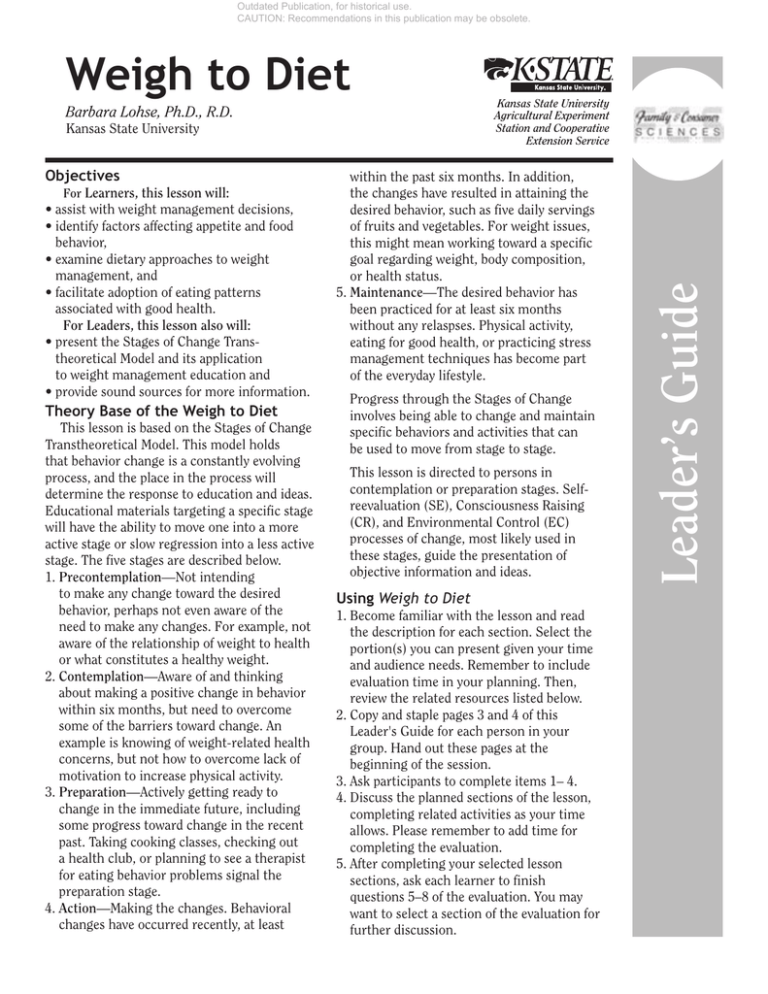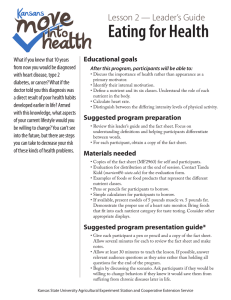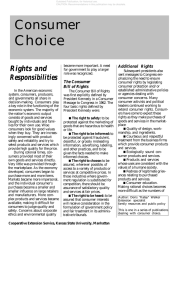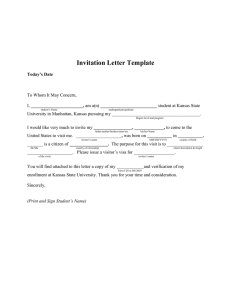
Outdated Publication, for historical use.
CAUTION: Recommendations in this publication may be obsolete.
Barbara Lohse, Ph.D., R.D.
Kansas State University
Objectives
For Learners, this lesson will:
• assist with weight management decisions,
• identify factors affecting appetite and food
behavior,
• examine dietary approaches to weight
management, and
• facilitate adoption of eating patterns
associated with good health.
For Leaders, this lesson also will:
• present the Stages of Change Transtheoretical Model and its application
to weight management education and
• provide sound sources for more information.
Theory Base of the Weigh to Diet
This lesson is based on the Stages of Change
Transtheoretical Model. This model holds
that behavior change is a constantly evolving
process, and the place in the process will
determine the response to education and ideas.
Educational materials targeting a specific stage
will have the ability to move one into a more
active stage or slow regression into a less active
stage. The five stages are described below.
1. Precontemplation—Not intending
to make any change toward the desired
behavior, perhaps not even aware of the
need to make any changes. For example, not
aware of the relationship of weight to health
or what constitutes a healthy weight.
2. Contemplation—Aware of and thinking
about making a positive change in behavior
within six months, but need to overcome
some of the barriers toward change. An
example is knowing of weight-related health
concerns, but not how to overcome lack of
motivation to increase physical activity.
3. Preparation—Actively getting ready to
change in the immediate future, including
some progress toward change in the recent
past. Taking cooking classes, checking out
a health club, or planning to see a therapist
for eating behavior problems signal the
preparation stage.
4. Action—Making the changes. Behavioral
changes have occurred recently, at least
Kansas State University
Agricultural Experiment
Station and Cooperative
Extension Service
within the past six months. In addition,
the changes have resulted in attaining the
desired behavior, such as five daily servings
of fruits and vegetables. For weight issues,
this might mean working toward a specific
goal regarding weight, body composition,
or health status.
5. Maintenance—The desired behavior has
been practiced for at least six months
without any relaspses. Physical activity,
eating for good health, or practicing stress
management techniques has become part
of the everyday lifestyle.
Progress through the Stages of Change
involves being able to change and maintain
specific behaviors and activities that can
be used to move from stage to stage.
This lesson is directed to persons in
contemplation or preparation stages. Selfreevaluation (SE), Consciousness Raising
(CR), and Environmental Control (EC)
processes of change, most likely used in
these stages, guide the presentation of
objective information and ideas.
Using Weigh to Diet
1. Become familiar with the lesson and read
the description for each section. Select the
portion(s) you can present given your time
and audience needs. Remember to include
evaluation time in your planning. Then,
review the related resources listed below.
2. Copy and staple pages 3 and 4 of this
Leader's Guide for each person in your
group. Hand out these pages at the
beginning of the session.
3. Ask participants to complete items 1– 4. 4. Discuss the planned sections of the lesson,
completing related activities as your time
allows. Please remember to add time for
completing the evaluation.
5. After completing your selected lesson
sections, ask each learner to finish
questions 5–8 of the evaluation. You may
want to select a section of the evaluation for
further discussion.
Leader’s Guide
Weigh to Diet
Outdated Publication, for historical use.
CAUTION: Recommendations in this publication may be obsolete.
6. Read the statement of informed consent.
Ask persons to turn in their evaluation so
that you may mail them as a group to the
researcher. Bring a few envelopes in case
some prefer to mail theirs separately. Mail
the completed evaluations to Barbara Lohse,
Department of Human Nutrition, 203 Justin
Hall, Manhattan, KS 66506.
Lesson Sections (Stage of Change
Process)
A. Body Measures. Body mass index and
waist circumference and how they are used
(CR).
B. Weight and Health. What is a healthy
weight? (SE and CR ).
C. Dieting. Two diets are examined;
evaluation guidelines given (CR, SE,
and EC).
D. Food Guide Pyramids. Three pyramids
are presented with opportunity to relate
them to intake (SE).
E. Appetite Control. Basic examples of
appetite’s biological aspect (CR).
F. Be Active and Stretch! Improves body
image and promotes physical activity (EC).
Community Awareness Activities
• Set up a display at a health or wellness event
to help consumers evaluate diet and eating
patterns.
• Prepare a program for middle school age
youth that focuses on the word DIET. Have
participants, either alone or in a group,
draw or discuss their meaning of diets. Then
discuss the real meaning of diet, criteria for
evaluating diets, and ask them to draw a new
meaning of the word DIET.
• Present information on appetite control to a
biology or psychology class.
• Prepare a poster/flyer to display in
community sites that allows viewers to
calculate and assess their body mass index.
• Prepare a display of several food guides (e.g.
USDA, Mayo Clinic, and New Food Guide
Pyramids) or dietary guidelines from a variety
of countries for people to compare with their
eating patterns.
• Develop a skit where the main character,
in looking for a healthy diet, must meet
and choose among several characters
representing several different weight loss
diets. The skit could also be a school-based
project requiring research about each diet.
Resources
Stages of Change Resources
Prochaska, J,O,, Norcross, J.C., DiClemente, C.C.
Changing for Good, A Revolutionary Six-Stage
Program for Overcoming Bad Habits and Moving
Your Life Positively Forward. New York: Avon Books;
1994.
www.uri.edu/research/cprc/TTM/StagesOfChange
.htm
Key features of the Transtheoretical Stages of
Change Model are described.
http://oc.nci.nih.gov/services/theory_at_glance/
home.html
Numerous health behavior theories are explained
including the Stages of Change Model.
Prochaska, J.O., Velicer, W.F. The transtheoretical
model of health behavior change. American Journal
of Health Promotion 12(1):38–48; 1997.
Sandoval, W.M., Heller, K.E., Wiese, W.H., Childs, DA.
Stages of change: A model for nutrition counseling.
Topics in Clinical Nutrition 9(3): 64–69; 1994.
The Center for Weight and Health,
University of California-Berkeley
www.cnr.berkeley.edu/cwh/
The mission of this center is to provide leadership
for the development of interdisciplinary, sciencebased solutions to body weight, health and hungerrelated problems. The Web site includes many
resources and program materials.
The U.S. Dietary Guidelines, USDA
www.cnpp.usda.gov/DietGd.pdf
This 44-page brochure details the dietary guidelines
for Americans. Pages 8–15 focus on healthy weight
and physical activity.
Mayo Clinic
www.mayoclinic.com/ Go to Health Centers: Food
and Nutrition Center, then select Weight Control
under the Exploring Food and Health Section.
Explore information about metabolism, weight
management strategies, and how to evaluate them.
National Institutes of Health
www.nhlbi.nih.gov/guidelines/obesity/prctgd_c.pdf
A 94-page guide to help identify, evaluate, and treat
overweight and obesity in adults. Page 9 has ten
steps to treat overweight and obesity.
Thanks to the following reviewers:
Linda Boeckner, Ph.D., R.D.
University of Nebraska, Lincoln, Neb.
Kathy Grunewald, Ph.D., R.D.
Kansas State University, Manhattan, Kan.
Adrienne White, Ph.D., R.D.
University of Maine, Orono, Maine
Outdated Publication, for historical use.
CAUTION: Recommendations in this publication may be obsolete.
Please let us know about YOU!­­
1. In the past month, has your lifestyle supported having a healthy weight?
Yes
No
a.If you answered yes, have you had a healthy lifestyle for more than 6 months?
Yes
No
b. I f you answered No to question 1, are you seriously considering lifestyle changes to have a
healthy weight in the next 30 days?
Yes
No The next 6 months?
Yes
No
2. Give or take 5 pounds, do you know how much you weigh?
Yes
No
3. Do you know your Body Mass Index (BMI)?
No
Yes If yes, what is it?
4. Below is a list of different foods. Using the scale provided, circle the number that best represents how much you like or dislike each food item. If you have never tried the food or think you would not
try the food, indicate this by checking the appropriate column.
USE THIS SCALE: 1=Dislike Extremely; 5=Neither Dislike/Like; 9=Like Extremely
1=Dislike 9=Like
Food ItemExtremely Extremely
Apples
Apricots
Cantaloupe
Watermelon
Strawberries
Oranges
Orange juice
Grapefruit
Green beans
Peas
Chili with beans
Baked beans
Corn
Baked yellow squash
Raw tomatoes
Broccoli
Cauliflower
Spinach (raw)
Spinach (cooked)
Cabbage (cooked)
Carrots (raw)
Tossed green salad
Mayonnaise
French fries
Sweet potatoes
Baked potatoes
Cooked onions
Hamburgers
Beef and steak
Pork chops
Fried chicken
Grilled chicken
Tuna salad
Shrimp
Spaghetti
Pizza
Macaroni and cheese
Hot dogs
Lunch meats
Vegetable soup
Split pea soup
White bread
Whole-wheat bread
Corn bread
Peanut butter
Butter on bread
Margarine on bread
1
1
1
1
1
1
1
1
1
1
1
1
1
1
1
1
1
1
1
1
1
1
1
1
1
1
1
1
1
1
1
1
1
1
1
1
1
1
1
1
1
1
1
1
1
1
1
2
2
2
2
2
2
2
2
2
2
2
2
2
2
2
2
2
2
2
2
2
2
2
2
2
2
2
2
2
2
2
2
2
2
2
2
2
2
2
2
2
2
2
2
2
2
2
3
3
3
3
3
3
3
3
3
3
3
3
3
3
3
3
3
3
3
3
3
3
3
3
3
3
3
3
3
3
3
3
3
3
3
3
3
3
3
3
3
3
3
3
3
3
3
4
4
4
4
4
4
4
4
4
4
4
4
4
4
4
4
4
4
4
4
4
4
4
4
4
4
4
4
4
4
4
4
4
4
4
4
4
4
4
4
4
4
4
4
4
4
4
5
5
5
5
5
5
5
5
5
5
5
5
5
5
5
5
5
5
5
5
5
5
5
5
5
5
5
5
5
5
5
5
5
5
5
5
5
5
5
5
5
5
5
5
5
5
5
6
6
6
6
6
6
6
6
6
6
6
6
6
6
6
6
6
6
6
6
6
6
6
6
6
6
6
6
6
6
6
6
6
6
6
6
6
6
6
6
6
6
6
6
6
6
6
7
7
7
7
7
7
7
7
7
7
7
7
7
7
7
7
7
7
7
7
7
7
7
7
7
7
7
7
7
7
7
7
7
7
7
7
7
7
7
7
7
7
7
7
7
7
7
8
8
8
8
8
8
8
8
8
8
8
8
8
8
8
8
8
8
8
8
8
8
8
8
8
8
8
8
8
8
8
8
8
8
8
8
8
8
8
8
8
8
8
8
8
8
8
Never
Tried
Would
Not Try
9
9
9
9
9
9
9
9
9
9
9
9
9
9
9
9
9
9
9
9
9
9
9
9
9
9
9
9
9
9
9
9
9
9
9
9
9
9
9
9
9
9
9
9
9
9
9
Outdated Publication, for historical use.
CAUTION: Recommendations in this publication may be obsolete.
1=Dislike Food Item Extremely
Shredded wheat
Oatmeal
Eggs
Bacon
Sausage
Ice cream
Pastries
Pumpkin pie
Apple pie
Chocolate candy
Cottage cheese
Sharp cheddar cheese
Fruit-flavored yogurt
Whole milk
Skim milk
Soft drinks
Diet soft drinks
Beer
Gin
Decaffeinated coffee
Coffee
Tea
Lemon in Tea
Milk in coffee
Cream in coffee
Sugar in coffee
Equal in coffee
Water (tap or bottled)
1
1
1
1
1
1
1
1
1
1
1
1
1
1
1
1
1
1
1
1
1
1
1
1
1
1
1
1
2
2
2
2
2
2
2
2
2
2
2
2
2
2
2
2
2
2
2
2
2
2
2
2
2
2
2
2
3
3
3
3
3
3
3
3
3
3
3
3
3
3
3
3
3
3
3
3
3
3
3
3
3
3
3
3
4
4
4
4
4
4
4
4
4
4
4
4
4
4
4
4
4
4
4
4
4
4
4
4
4
4
4
4
5
5
5
5
5
5
5
5
5
5
5
5
5
5
5
5
5
5
5
5
5
5
5
5
5
5
5
5
6
6
6
6
6
6
6
6
6
6
6
6
6
6
6
6
6
6
6
6
6
6
6
6
6
6
6
6
7
7
7
7
7
7
7
7
7
7
7
7
7
7
7
7
7
7
7
7
7
7
7
7
7
7
7
7
9=Like
Extremely
8
8
8
8
8
8
8
8
8
8
8
8
8
8
8
8
8
8
8
8
8
8
8
8
8
8
8
8
Never
Tried
Would
Not Try
9
9
9
9
9
9
9
9
9
9
9
9
9
9
9
9
9
9
9
9
9
9
9
9
9 9
9
9
Drewnowski A, Hann C. American Journal of Clinical Nutrition 70:28-36; 1999.
Please answer the following questions only AFTER you have finished this lesson.
5. Are you seriously considering lifestyle changes to have a healthy weight in the next 30 days?
Yes
No The next 6 months?
Yes
No
6. Circle the letter corresponding to the section(s) studied: A
B
C
D
E
F
No
Yes If yes, what is it?
7. Do you know your BMI?
8. Please provide some comments about what you learned and the usefulness of the lesson.
Statement of Informed Consent
In addition to providing an evaluation of this lesson, your anonymous responses to the questions on pages 3 and 4 will
enable us to study diet and weight-related factors. You are not required to complete these questions or to return them to
the leader; however, if you so choose to do so, you are giving consent for them to be reviewed and analyzed by Barbara
Lohse. Surveys will be destroyed upon analysis. If you have any questions, you may call Dr. Lohse at 785-532-0154 or
Dr. Rick Scheidt at 785-532-1483. Please send surveys to Dr. Lohse at Department of Human Nutrition, 203 Justin Hall,
Manhattan, KS 66506‑
Brand names appearing in this publication are for product identification purposes only.
No endorsement is intended, nor is criticism implied of similar products not mentioned.
Publications from Kansas State University are available on the World Wide Web at: http://www.oznet.ksu.edu
Publications from Kansas State University may be freely reproduced for educational purposes. All other rights reserved.
In either case, credit Barbara Lohse, Ph.D., R.D., Weigh to Diet, August 2003.
Kansas State University Agricultural Experiment Station and Cooperative Extension Service , Manhattan, Kansas
MF-2596
AUGUST 2003
It is the policy of Kansas State University Agricultural Experiment Station and Cooperative Extension Service that all persons shall have equal opportunity and access to its
educational programs, services, activities, and materials without regard to race, color, religion, national origin, sex, age, or disability. Kansas State University is an equal opportunity
organization. These materials may be available in alternative formats.
Issued in furtherance of Cooperative Extension Work, Acts of May 8 and June 30, 1914, as amended. Kansas State University, County Extension Councils, Extension Districts, and
United States Department of Agriculture Cooperating, Marc A. Johnson, Director.




